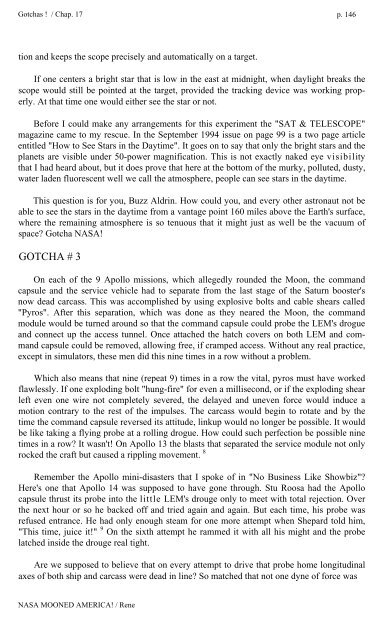Rene-NASA-Mooned-America
Rene-NASA-Mooned-America
Rene-NASA-Mooned-America
Create successful ePaper yourself
Turn your PDF publications into a flip-book with our unique Google optimized e-Paper software.
Gotchas ! / Chap. 17 p. 146<br />
tion and keeps the scope precisely and automatically on a target.<br />
If one centers a bright star that is low in the east at midnight, when daylight breaks the<br />
scope would still be pointed at the target, provided the tracking device was working properly.<br />
At that time one would either see the star or not.<br />
Before I could make any arrangements for this experiment the "SAT & TELESCOPE"<br />
magazine came to my rescue. In the September 1994 issue on page 99 is a two page article<br />
entitled "How to See Stars in the Daytime". It goes on to say that only the bright stars and the<br />
planets are visible under 50-power magnification. This is not exactly naked eye visibility<br />
that I had heard about, but it does prove that here at the bottom of the murky, polluted, dusty,<br />
water laden fluorescent well we call the atmosphere, people can see stars in the daytime.<br />
This question is for you, Buzz Aldrin. How could you, and every other astronaut not be<br />
able to see the stars in the daytime from a vantage point 160 miles above the Earth's surface,<br />
where the remaining atmosphere is so tenuous that it might just as well be the vacuum of<br />
space Gotcha <strong>NASA</strong>!<br />
GOTCHA # 3<br />
On each of the 9 Apollo missions, which allegedly rounded the Moon, the command<br />
capsule and the service vehicle had to separate from the last stage of the Saturn booster's<br />
now dead carcass. This was accomplished by using explosive bolts and cable shears called<br />
"Pyros". After this separation, which was done as they neared the Moon, the command<br />
module would be turned around so that the command capsule could probe the LEM's drogue<br />
and connect up the access tunnel. Once attached the hatch covers on both LEM and command<br />
capsule could be removed, allowing free, if cramped access. Without any real practice,<br />
except in simulators, these men did this nine times in a row without a problem.<br />
Which also means that nine (repeat 9) times in a row the vital, pyros must have worked<br />
flawlessly. If one exploding bolt "hung-fire" for even a millisecond, or if the exploding shear<br />
left even one wire not completely severed, the delayed and uneven force would induce a<br />
motion contrary to the rest of the impulses. The carcass would begin to rotate and by the<br />
time the command capsule reversed its attitude, linkup would no longer be possible. It would<br />
be like taking a flying probe at a rolling drogue. How could such perfection be possible nine<br />
times in a row It wasn't! On Apollo 13 the blasts that separated the service module not only<br />
rocked the craft but caused a rippling movement. 8<br />
Remember the Apollo mini-disasters that I spoke of in "No Business Like Showbiz"<br />
Here's one that Apollo 14 was supposed to have gone through. Stu Roosa had the Apollo<br />
capsule thrust its probe into the little LEM's drouge only to meet with total rejection. Over<br />
the next hour or so he backed off and tried again and again. But each time, his probe was<br />
refused entrance. He had only enough steam for one more attempt when Shepard told him,<br />
"This time, juice it!" 9 On the sixth attempt he rammed it with all his might and the probe<br />
latched inside the drouge real tight.<br />
Are we supposed to believe that on every attempt to drive that probe home longitudinal<br />
axes of both ship and carcass were dead in line So matched that not one dyne of force was<br />
<strong>NASA</strong> MOONED AMERICA! / <strong>Rene</strong>


